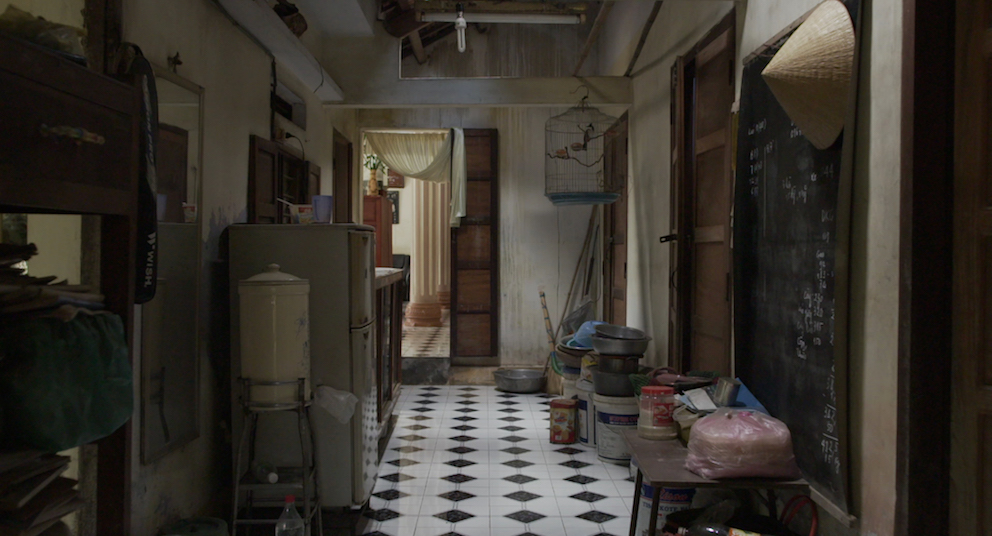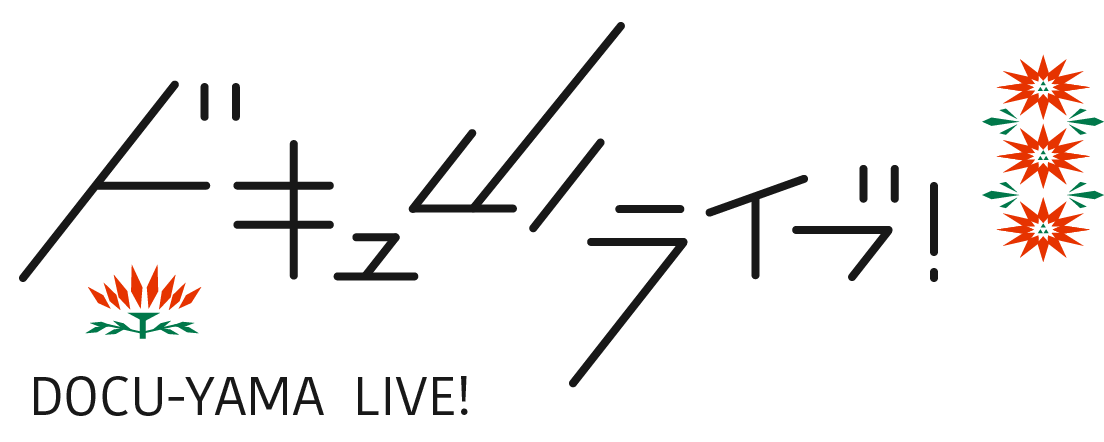The Yamagata Film Criticism Workshop will take place for the forth time during YIDFF 2017. This project encourages thoughtful writing on and discussion of cinema, while offering aspiring film critics the chance to immerse themselves in the lively atmosphere of a film festival.
Silent Thresholds
Philip Widmann and Nguyễn Phương-Đan’s A House in Ninh Hoa
by Nguyễn-Hoàng Quyên

A House in Ninh Hoa (Philip Widmann and Nguyễn Phương-Đan, 2016) begins with ostensible sparseness: a translucent window, a narrow corridor, a plain staircase – ethereal hints of passages in space and time, tinged with unnamable melancholy. The camera continues to linger in pedestrian places: a chair encased in plastic sheets, a sunlit suburban rooftop, a view of red tiles and utility poles, a green grain expanse. In this opening series of static frames, time, neither compressed nor expanded, flows with nonchalance.
Mounted by the village road, a public radio presents unexciting news like the People’s Council’s goal for rural development or the police’s record of “2397 traffic violations.” The broadcast music, a gleeful tune recalling propagandist songs of 20th-century Vietnam, feels strangely out of place in an agrarian landscape that, despite its pastoral air, exudes more desolation and abandonment than collective labor and joyful productivity. Throughout the film, inescapable echoes of honking motorcycles and relentless construction signal an ever-encroaching wave of gentrification.
The sonic charm of the documentary, a non-fictional experiment with a dramaturgical framework, lies in the soundscapes of talking insects, crowing roosters and surging ocean waves, inserted between wandering dialogues like wordless refrains. These nonhuman sounds, easily overlooked as ‘rural ambience,’ musically fulfill a curative role as they spare viewers from the commotion of urban hustle and the tyranny of speech.
***
The scaffold of the story has to do with three sons from a family in Ninh Hoa, a small coastal town of Vietnam. During the Vietnam-American war, all three of them worked for the South Vietnamese regime. The first brother, a diplomatic official, migrated to Germany with his wife and children in the early 1970s. The second brother, a soldier, went missing in Cu Chi in 1975, right around the event known as the Liberation or Fall of Saigon, depending on who the speaker is. The third one, Tiếp, also drafted by the Southern Vietnamese Army, was sent to a re-education camp after the war formally ended. He is now the only male left in the family’s Ninh Hoa house.
This armature of information, divulged in fragments all through the film, is cleverly reiterated in the coda as a report handwritten and read aloud by Tiếp. This oral summary of his family history delineates dates, departures and deaths in a distinctly detailed and linear manner. The scene is the only instance in which Tiếp speaks for an extended period of time. Throughout the film, he either naps, peruses some old papers or wanders off on his own. The final report gives Tiếp, a ‘re-educated’ veteran who perhaps still lives with trauma, a chance to delicately acknowledge his frail health, or in other words, his failure to perform the hyper-masculine conception of familial and national duty expected of a Vietnamese patriarch.
***
The most active people in the film are therefore not the supposed protagonists of the story, the sons who have gone missing, passed away or remained as feeble presence. It is the women who run the household with their soundless, meticulous and humble grace that embodies the way life unfolds here.
Consider the scene in which Tiếp’s mother, a benign nonagenarian matron, seated on a miniscule wooden stool, unhurriedly separates betel leaves over a sifter on the porch, a relic habit left over from pre-modern Vietnam. Later, resting by the dining table, she looks out the door at something off frame. Outside, clouds are passing, as the sunlit hue in the room shifts to a cool shade of blue. Neither the abrupt change in light nor the inexorable passage of time, as constantly recalled to mind by the multiple calendars on the wall, disturbs the old woman who continues to sit unfazed, suspended in some midafternoon observation.
Or consider the scene in the family’s second house, a new but uninhabited place, where one of the matron’s unmarried daughters drops in and kneels before a modest altar on the ground. As she lights a couple of incense sticks and starts praying to the house spirits, a faint whiff of white smoke ascends, filling the vacant room with quiet piety.
***
The intimacy of faith in A House in Ninh Hoa shows even in the most mundane gesture of devotion. In the family’s main house, the other unmarried daughter climbs onto a stool with bare feet to clean an altar overhead. In the same methodical manner, she goes through a row of ancestral photographs on the lower platform, dusting each picture frame with a small piece of cloth. The deceased all happen to be male, lost to either war or time. Cleaning altars must be a familiar routine, like the act of burning joss money for the dead, but the deliberate care in each polish generates a strange closeness between the female presence and the funerary portraits, and by extension, between the viewers and the daily worship act on the screen.
Besides regular caretaking rituals around the altar, excavating familial mementos is another occasion for the body of the living to connect with the imprint of the dead. People are often caught in solemn reveries, fingering faded photographs, unearthing fragile correspondence from messy cabinets, leafing through a wartime high school yearbook, dipping into the deluge of memories with aging hands. Each family member’s encounter with an old postcard or letter is tinted with mixed sadness and joy at the recognition of a beloved scribble. Viewers could almost feel the shiver in the sisters’ hands and their unarticulated regret. As our sight follows their fingers coming into contact with these charged artifacts, our bodies sensorially partake in the communion. Sheer close attention, on the part of the camera and the viewers, translates the filmic into the corporeal, even if translation is never a perfect transference. No longer a mediating barrier, the screen reveals itself as a potential medium through which the visual and the haptic might not wholly coalesce but sensuously blur and travel between the viewer and the viewed.
***
Material artifacts such as pictures, certificates or correspondence, as well as attentive documentation of these grave relics through the porous medium of cinema, are, however, not the only entrances into the invisible world of spirits. Furthering its discreet interest in the animated lives of specters, A House in Ninh Hoa plays with a repeated anecdote related to reincarnation. Twice in the film, one elder daughter tells the hunchbacked matron a deadpan tale about finding long-lost blood relatives through propitious dreams. Her two stories, or dual variations of a single fable, share a supernatural core: a bereft protagonist goes to a pagoda and recognizes a monk who looks identical to the dead beloved. These apocryphal stories intimate an indistinguishable desire for resolution via the pursuit of transmigrated lives.
In reality, the family does not stumble on such a fortuitous closure. Upon his return to Vietnam, the matron’s Germany-raised grandson starts a patient search for his missing uncle’s unknown trace. He visits a medium in Ha Noi who, after gathering the uncle’s biographical details, collecting his photographs and beseeching the spirits in hushed prayers, fails to make a connection. There is still hope, the medium suggests, if they perform the ceremony again somewhere closer to the uncle’s past dwelling in Ninh Hoa. For now, the absent remains missing. Still, much of the film, no less than the family’s persistent discomfort, revolves around this man’s disappearance and his grandson’s restless urge to locate an answer. The unending presence of absence has orchestrated a dramaless drama to unfold and enfold our attention.
***
A House in Ninh Hoa defies stereotypes about documentaries tied to Vietnam and the war. The politics and aesthetics of the film are neither pedagogical ‘agitprop,’ embodied by militant films in the past such as Loin du Vietnam (edited by Chris Marker, 1967), nor an attempted participation in the now popular narrative of war victims overcoming illness and trauma, as seen in numerous Vietnamese and American documentaries on veterans and people living with war aftereffects. Perhaps because A House in Ninh Hoa was co-written by Nguyễn Phương-Đan, one of the family’s diasporic great-grandchildren, and Philip Widmann, a stranger invited into these national and familial entanglements, the hybrid result is infused with a strange mix of reverent intimacy and uninvolved distance.
The film bypasses clichéd materials such as historical footage of the war or journalistic interviews with survivors. Loss and exile are intimated via fleeting mentions of an unbearably long flight, a dizzying escape in the night, and the reality of a family truncated into separate parts across Vietnam and Germany. The emotional gravity of the film is initiated by postwar exits and reunions, but it spills beyond the war discourse. The filmmakers’ loosely staged framework enables the family’s improvised dialogues to transpire in a graspable form and simultaneously digress far from Vietnam’s perennially marked topic of war. Capaciously, the documentary observes and disseminates questions around the rhythm and unease of suburban life, the depth of intergenerational haunting, and possible throughways between the living and the dead.
Trinh T. Minh-ha once suggested filmmaking as an act of “speaking nearby” instead of seizing, explaining or “speaking about” the poetry of things. In a similar vein of softly keeping absence astir, the makers of A House in Ninh Hoa relinquish the impulse to capture or overdramatize a family’s private ghosts. Graceful moments of the film approach a silence nearby. Like the recurring hazy window in the empty house, the film is a semitransparent threshold through which tension and serenity, past hurt and present endurance, current searches and future cures, slip through. In the unresolved search of a wound-closing spell, comfort is found in sacred routines and mystical forces around what remains.
![ドキュ山ライブ! [DOCU-YAMA LIVE!]](http://www.yidff-live.info/wp-content/themes/yidff-live_2017/images/header_sp_logo1.png)

